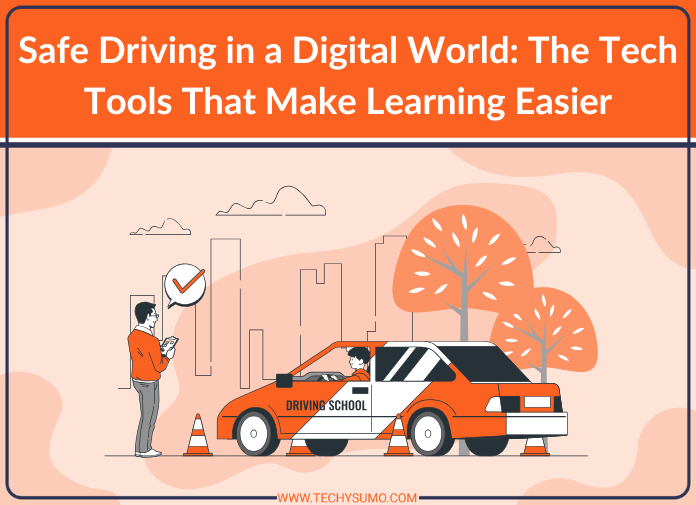Driving has always required skill, patience, and practice, but the digital era has introduced tools that make learning to drive safer and more efficient. Technology is reshaping how new drivers gain confidence on the road, from mobile apps and simulators to AI-powered coaching and telematics. Whether you’re a beginner preparing for your test or an experienced driver looking to refine your skills, the right tech can enhance your learning experience and improve road safety.
Table of Contents
- Finding the Right Driving School
- Interactive Driving Simulators
- Mobile Apps for Learning Road Rules and Practicing Tests
- AI-Powered Driving Assistants
- Telematics and Black Box Technology
- Dash Cams for Learning and Safety
- Online Driving Schools and Virtual Lessons
- The Role of Smart Cars in Driving Education
- Conclusion
Finding the Right Driving School
While technology plays a crucial role in driving education, finding a reputable driving school remains essential. A well-structured driving course, combined with modern tools, creates a comprehensive learning experience. For those in Wolverhampton looking for expert instruction, Driving School Wolverhampton provides professional training with experienced instructors who help learners build confidence on the road.
Interactive Driving Simulators
Driving simulators offer a risk-free environment to practice essential skills before getting behind the wheel. These programs replicate real-world driving conditions, helping learners build muscle memory and reaction times. Some high-end simulators even mimic different weather conditions and road hazards, allowing new drivers to experience challenging situations without actual risk.
For driving schools and independent learners, these simulators provide a great way to reinforce lessons. Some even integrate virtual reality (VR), offering an immersive experience that mimics real-life driving scenarios. This kind of practice enhances situational awareness and decision-making before learners take to the road.
Mobile Apps for Learning Road Rules and Practicing Tests
Several mobile apps help learners master road rules and prepare for their theory test. These apps offer practice questions, interactive road signs, and even hazard perception tests. Some popular options include:
Also Read
- Driving Theory Test Apps – Provide mock tests with updated questions based on official licensing exams.
- Navigation and Route Planning Apps – Help learners understand road layouts, intersections, and the best driving routes.
- Augmented Reality (AR) Road Safety Apps – Allow users to experience real-world driving scenarios using their smartphone cameras.
These apps make studying for the test more engaging and effective, especially for those who learn better through interactive experiences rather than reading manuals.
AI-Powered Driving Assistants

Artificial intelligence is making its way into driving education through AI-powered coaching systems. Some modern vehicles come equipped with AI assistants that provide real-time feedback on driving habits. For example, these tools can analyze braking patterns, acceleration control, and steering input to suggest improvements.
For learners, AI-driven coaching apps can act as virtual instructors, offering personalized feedback. Some even track progress over time, highlighting areas that need improvement. This data-driven approach helps learners build confidence while ensuring they adopt safe driving habits from the beginning.
Telematics and Black Box Technology
Telematics devices, also known as black boxes, monitor driving behavior by collecting data on speed, braking, cornering, and other factors. Many insurance companies use telematics to offer discounts to safe drivers, making it a valuable tool for learners and newly licensed drivers looking to lower their insurance premiums.
Must Read: All the types of car insurance you should know
Some driving schools incorporate telematics into lessons to provide instant feedback on driving performance. Learners can adjust their habits by reviewing their driving data and working on specific weaknesses. Parents of teenage drivers can also use telematics apps to monitor their child’s driving habits, ensuring they stay safe on the road.
Dash Cams for Learning and Safety
Dash cams are becoming increasingly popular among new drivers and instructors. These devices record footage of each drive, allowing learners to review their performance and identify mistakes. Instructors can use recorded footage to provide constructive feedback, pointing out areas where improvements are needed.
Beyond learning, dash cams serve as a safety measure by documenting road incidents. In case of an accident or dispute, having video evidence can be invaluable. Many advanced dash cams even come with AI features that alert drivers to potential hazards, acting as an extra set of eyes on the road.
Online Driving Schools and Virtual Lessons
For those who prefer remote learning, online driving schools offer an alternative to traditional in-person lessons. These platforms provide video tutorials, interactive quizzes, and virtual coaching sessions to help learners grasp driving concepts. Some services even offer one-on-one online consultations with instructors who can guide students through specific challenges.
Incorporating online learning into driving education allows learners to study at their own pace, making it easier to balance lessons with their daily schedules. It also provides access to a wealth of educational materials that might not be available in traditional classroom settings.
Learning to drive is easier and safer with the right technology. In our previous blog, Shining Star Driving School in Wethersfield, CT, we explored a trusted driving school that helps new drivers gain confidence on the road. Now, with modern tech tools like driving simulators, GPS apps, and online learning platforms, students can practice and improve their skills even before getting behind the wheel. These digital advancements make learning to drive more accessible, efficient, and safe.
The Role of Smart Cars in Driving Education
Smart cars equipped with advanced driver assistance systems (ADAS) are transforming the way people learn to drive. Features like adaptive cruise control, lane-keeping assistance, and automatic emergency braking help learners develop safe driving habits. While these tools should never replace proper instruction, they act as safety nets that reduce the risk of accidents during the learning process.
Some driving schools are integrating smart cars into their training programs, allowing students to experience how technology enhances road safety. These features assist learners and prepare them for the increasing automation in modern vehicles.
Conclusion
Technology is reshaping the way people learn to drive, offering tools that make the process more interactive, safe, and efficient. These innovations, from simulators and AI-powered assistants to telematics and dash cams, help learners develop essential driving skills with greater confidence. However, technology should complement—not replace—traditional instruction. Combining digital tools with expert guidance ensures that new drivers gain the knowledge and experience needed to navigate the roads safely.
As digital advancements continue to evolve, the future of driving education will become even more personalized and data-driven, making learning to drive safer and more accessible for everyone.






